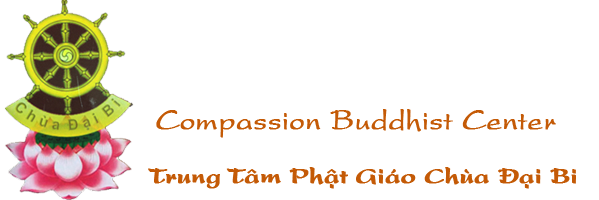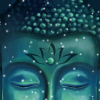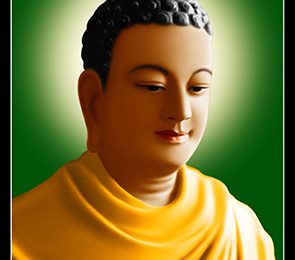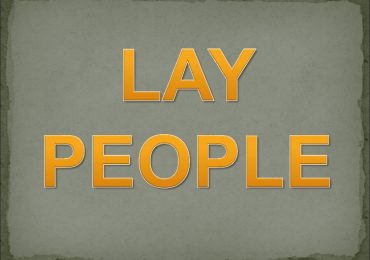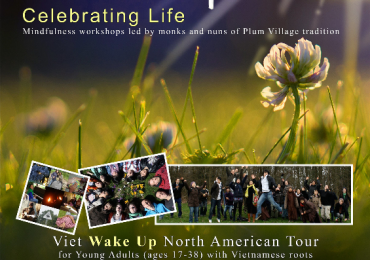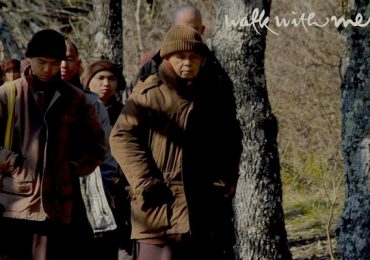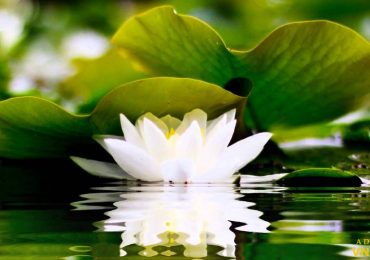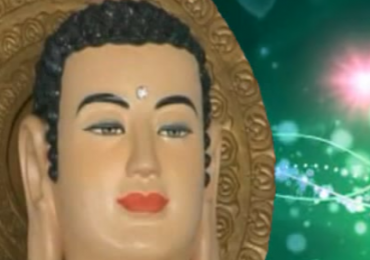Resting in the River
My dear friends, suppose someone is holding a pebble and throws it in the air and the pebble begins to fall down into a river. After the pebble touches the surface of the water, it allows itself to sink slowly into the river.
It will reach the bed of the river without any effort. Once the pebble is at the bottom of the river, it continues to rest. It allows the water to pass by.
I think the pebble reaches the bed of the river by the shortest path because it allows itself to fall without making any effort. During our sitting meditation we can allow ourselves to rest like a pebble. We can allow ourselves to sink naturally without effort to the position of sitting, the position of resting.
Resting is a very important practice; we have to learn the art of resting. Resting is the first part of Buddhist meditation. You should allow your body and your mind to rest. Our mind as well as our body needs to rest.
The problem is that not many of us know how to allow our body and mind to rest. We are always struggling; struggling has become a kind of habit. We cannot resist being active, struggling all the time. We struggle even during our sleep.
It is very important to realize that we have the habit energy of struggling. We have to be able to recognize a habit when it manifests itself because if we know how to recognize our habit, it will lose its energy and will not be able to push us anymore.
Ten years ago I was in India visiting the ex-untouchable community of Buddhists. A friend who belonged to the caste organized the trip for me. I was sitting on the bus, enjoying the landscape outside, contemplating the palm trees and the vegetation. Suddenly I turned and I saw him looking very tense. There was no reason why he had to be tense like that. I thought that he was trying to make my visit pleasant and maybe that was the reason he was so tense. I told him, “Dear friend, I know that you want to make my trip pleasant, but I am already very happy. I’ve already enjoyed the trip. So why don’t you sit back, smile, and relax?” He said, “Okay,” and he sat back and he tried to relax.
I was pleased and I turned my face toward the window again and I enjoyed the palm trees and other things. But just a few minutes after when I looked back at him he was as tense as before. He was not able to relax, to allow himself to relax. I knew that he belonged to that section of the population that had been struggling for many thousand years. He was discriminated against. He had suffered so much, his ancestors and himself and his children. So the tendency to struggle has been there for many thousand years. That is why it was very difficult for him to allow himself to rest.
We have to practice in order to be able to transform this habit in us. The habit of struggle has become a powerful source of energy that is shaping our behavior, our actions and our reactions.
When an animal in the jungle is wounded, it knows how to find a quiet place, lie down and do nothing. The animal knows that is the only way to get healed-to lay down and just rest, not thinking of anything, including hunting and eating. Not eating is a very wonderful way of allowing your body to rest. We are so concerned about how to get nutrition that we are afraid of resting, of allowing our body to rest and to fast. The animal knows that it does not need to eat. What it needs is to rest, to do nothing, and that is why its health is restored.
In our consciousness there are wounds also, lots of pains. Our consciousness also needs to rest in order to restore itself. Our consciousness is just like our body. Our body knows how to heal itself if we allow it the chance to do so. When we get a cut on our finger we don’t have to do anything except to clean it and to allow it the time to heal, because our body knows how to heal itself. The same thing is true with our consciousness; our consciousness knows how to heal itself if we know how to allow it to do so. But we don’t allow it. We always try to do something. We worry so much about healing, which is why we do not get the healing we need. Only if we know how to allow them to rest can our body and our soul heal themselves.
But there is in us what we call the energy of restlessness. We cannot be at peace with ourselves. We cannot be peaceful. We cannot sit; we cannot lie down. There is some energy in us to do this, to do that, to think of this, to think of that, and that kind of restlessness makes us unhappy. That is why it is so important for us to learn first of all to allow our body to rest. We have to learn how to deal with all our energy of restlessness. That is why we have to learn these techniques of allowing our body and our consciousness to rest.
I would like to offer you some instructions about walking meditation. The first thing we shall do early tomorrow morning is to practice walking together, which we call walking meditation. Walking meditation means to enjoy walking without any intention to arrive. We don’t need to arrive anywhere. We just walk. We enjoy walking. That means walking is already stopping, and that needs some training.
Usually in our daily life we walk because we want to go somewhere. Walking is only a means to an end, and that is why we do not enjoy every step we take. Walking meditation is different. Walking is only for walking. You enjoy every step you take. So this is a kind of revolution in walking. You allow yourself to enjoy every step you take.
The Zen master Ling Chi said that the miracle is not to walk on burning charcoal or in the thin air or on the water; the miracle is just to walk on earth. You breathe in. You become aware of the fact that you are alive. You are still alive and you are walking on this beautiful planet. That is already performing a miracle. The greatest of all miracles is to be alive. We have to awaken ourselves to the truth that we are here, alive. We are here making steps on this beautiful planet. This is already performing a miracle.
But we have to be here in order for the miracle to be possible. We have to bring ourselves back to the here and the now. Therefore each step we take becomes a miracle. If you are able to walk like that, each step will be very nourishing and healing. You walk as if you kiss the earth with your feet, as if you massage the earth with your feet. There is a lot of love in that practice of walking meditation.
The Buddha said that the past is gone and the future is not yet here. Let us not regret the past. Let us not worry about the future. Go back to the present moment and live deeply the present moment. Because the present moment is the only moment where you can touch life. Life is available only in the present moment. That is why walking meditation is to go back to the present moment, in order to be alive again and to touch life deeply in that moment. In order to be able to touch the earth with our feet and enjoy walking, we have to establish ourselves firmly in the present moment, in the here and the now.
In walking meditation, we walk like a free person. This is not political freedom. This is freedom from afflictions, from sorrow, from fear. Unless you are free you cannot enjoy walking. I would like to propose to you a short poem that you might like to use for walking meditation:
I have arrived. I am home.
In the here. In the now.
I am solid. I am free.
In the ultimate I dwell.
You might like to take two steps and breathe in and say, I have arrived, I have arrived. And when you breathe out, you take another two steps and say silently, I am home, I am home. Our true home is really in the here and in the now. Because only in the here and the now can we touch life. As the Buddha said, life is available only in the here and the now, so going back to the present moment is going home. That is why you take one step or two steps and you awaken to the fact that you have arrived. You have arrived in the present moment.
If you are able to arrive, then you will stop running-running within and running without. There is a belief in us that happiness cannot be possible in the here and the now. We have to go somewhere. We have to go to the future in order to be able to really be happy. That kind of thinking has been there for a long time. Maybe that feeling has been transmitted to us from our ancestors and our parents. That is why we have to wake up to the presence of that habit energy in us and to do the reverse. The Buddha said that it is possible for us to be peaceful and happy in the present moment. That is the teaching of trista dharma sadha vihara. It means living happily right in the present moment. When you are there, body and mind united, you have an opportunity to touch the conditions of your happiness. If you are able to touch these conditions of happiness that are already available in the here and the now, you can be happy right away. You don’t have to run anywhere, especially into the future.
When we practice walking, we might be aware that we have strong feet. Our feet are strong enough for us to enjoy running and walking. That is one condition for happiness that is available. When I breathe in and I become aware of my eyes, I encounter another condition for my happiness. Breathing in, I am aware of my eyes. Breathing out, I smile to my eyes. This is an exercise, a very simple exercise to help you realize that you have eyes which are still in good condition. You need only to open your eyes to see the blue sky, the white cloud, the luxurious vegetation. You can see all kinds of forms and colors just because you have eyes still in good condition. Your eyes are another condition for your happiness. We have so many conditions like that for our happiness and yet we are still unhappy. We still want to run away from the present moment, hoping we’ll find some happiness in the future.
Breathing in, I’m aware of my heart. Breathing out, I smile to my heart. That is another exercise. When you practice like that you touch your heart with your mindfulness. If you continue a minute, you realize that you still have a heart that functions normally. It is wonderful to have a heart that still functions normally. There are people who don’t have a heart like that and their deepest desire is to have a heart like you. So conditions for happiness may be more than enough for us to be happy, but we are not able to be happy because of that tendency to run away from the present moment.
To take an in-breath, to smile, and to touch the conditions of happiness that are available, is something that all of us can do. Because of that we can stop and establish ourselves in the present moment. That is the teaching of living happily in the present moment. Please train yourself to make the present moment, the here and the now, into your true home. That is the only home that we have. That is the only place where we can touch life. Everything we are looking for must be found in the here and the now. In that way walking meditation can be a great pleasure and can be very healing.
Do you have to make any effort to practice walking meditation? I don’t think so. It is like when you drink a glass of orange juice. Do you think that you have to make an effort in order to enjoy the orange juice? No. Walking is like that. To really enjoy a glass of orange juice, you have to be there one hundred per cent mind and body together. If you are there, mind and body firmly established in the present moment, then a glass of orange juice will become a real thing for you. You are real; therefore, the juice is real. And there life is real. Life exists. Life is deep during the time you drink your orange juice.
When you contemplate a beautiful sunset, do you have to make any effort? I don’t think so. You don’t have to make any effort in order to enjoy a beautiful sunset. You need only to be there, to be there mind and body together. But if your body is there and your mind is in the past or in the future, then the beautiful sunset will not be there for you.
There is a kind of energy that helps you to be there body and mind together. That energy is called mindfulness. Mindfulness is the capacity of being there body and mind united. When you drink your orange juice, drink mindfully and you will enjoy your juice because you are really there one hundred per cent. If your body and mind are united when you contemplate the beautiful sunset, it means that you are mindful. Mindfulness helps you to be there in order for the beautiful sunset to be there too. While you walk, if you allow yourself to be there mind and body together, then walking will become mindful walking; it will be healing, refreshing and nourishing.
To meditate means first of all to be there, to be on your cushion, to be on your walking meditation path. Eating also is a meditation if you are really there, present one hundred per cent with your food. The essential is to be there. So please when you practice walking meditation, don’t make any effort. Allow yourself to be like that pebble at rest. The pebble is resting at the bottom of the river and the pebble does not have to do anything. While you are walking, you are resting. While you are sitting, you are resting. If you struggle during your sitting meditation or walking meditation, you are not doing it right. The Buddha said, “My practice is the practice of non-practice.” That means a lot. Give up all struggle. Allow yourself to be, to rest.
I sit on my meditation cushion. I consider it to be something very pleasant. I don’t struggle at all on my cushion. I allow myself to be, to rest. I don’t make any effort and that is why I do not get any trouble while sitting. While sitting I do not struggle and that is why all my muscles are relaxed. If you struggle during your sitting meditation, you will very soon have pain in your shoulders and back and things like that. But if you allow yourself to be rested on your cushion you can sit very long, and each minute is light, refreshing, nourishing and healing.
It is not sitting in order to struggle to get enlightenment. No. Sitting first of all is for the pleasure of sitting. Walking first of all is for the pleasure of walking. And eating is for the pleasure of eating. And the art is to be there one hundred per cent.
When I was a novice I learned how to light a stick of incense in mindfulness. You see, when you light incense you think that the purpose of lighting incense is to have the incense pervading the Buddha’s home. But lighting the incense is just for lighting the incense. You pick up a stick of incense mindfully and you enjoy that, because it is by itself an act of meditation. During the time you pick up the stick of incense you are mindful, you are concentrated, you are real, because your body and your mind are together. And the stick of incense is real. When you strike a match, you do the same thing. During the time you strike a match, you only strike a match. You don’t do anything else. You don’t think of other things. You are perfectly mindful of striking a match. You are concentrated on it, and you enjoy the act of lighting the incense.
When you hold a stick of incense, it is the same. When I stick it into the incense burner, I put my left hand on my right hand. That is the tradition. Everyone in the Buddhist tradition lights incense in that way. The stick of incense is very light; one hand is enough in order to hold it. Why do you have to put your left hand on your right hand? Because it means that you are doing it with one hundred per cent of your body and your mind.
Be there truly. Be there one hundred per cent of yourself. In every moment of your daily life. That is the essence of true Buddhist meditation. Each of us knows that we can do that, so let us train to live each moment of our daily life deeply. That is why I like to define mindfulness as the energy that helps us to be there one hundred per cent. The energy of your true presence.
Breathing in-in the here, in the here. Breathing out-in the now, in the now. Although these are different words they mean exactly the same thing. I have arrived in the here. I have arrived in the now. I am home in the here. I am home in the now.
When you practice like that, you practice stopping. Stopping is the basic Buddhist practice of meditation. You stop running. You stop struggling. You allow yourself to rest, to heal, to calm.
And after a few minutes of practice you might switch into doing the third line-I am solid, I am free. This is not auto-suggestion. Why? Because if you have succeeded in arriving in the here and in the now you are much freer. You are free from the past, from the future, from your worries, from your fear. And you become much more solid; your steps become more solid and you become more solid in your body and in your mind. Solidity becomes a reality after a few minutes of arriving, of being home.
Solidity and freedom are two characteristics of nirvana. Nirvana is not something abstract. The Buddha said we can touch nirvana with our own body. So while you practice walking meditation you can begin to touch nirvana already with your body and your spirit. When you feel you are a little bit more solid, a little bit more free, then you begin to touch nirvana with your body and spirit. Solidity and freedom are the true base for your happiness and well being. No happiness, no well being, is possible without solidity and freedom.
The last line of the poem is wonderful. In the ultimate I dwell. In the ultimate. In the ultimate. I dwell. I dwell. The ultimate here is the true foundation of your being.
Let us visualize the waves on the ocean, several waves appearing on the surface of the ocean. Some waves are big, there are those that are small, and each wave seems to have its own life. A wave may have ideas like, “I am a wave. I am only a wave among many waves. I am smaller than the other wave. I am less beautiful. I last less than the other wave.” Ideas like that. A wave can be caught in jealousy, in fear, in discrimination.
But if the wave is able to bend down and touch the water within herself, it will realize that while it is a wave, it is at the same time water. Water is the foundation of the wave. While waves can be high and low, more and less beautiful, the water is free from all these notions. That is why if we are able to touch the foundation of our being, we can release our fear and our suffering.
Touching the foundation of our being means touching nirvana. Our foundation is not subjected to birth and death, being and non-being. A wave can live the life of a wave, but a wave can do much better than that. While living the life of a wave, a wave can live a life of the water. The more our solidity and our freedom grows, the deeper we touch the ground of our own being. That is the door for emancipation, for the greatest relief.
Throughout his tour, Thich Nhat Hanh addressed the specific issues of Americans in a series of question and answer periods. Here is a selection of his responses to questions on leading a spiritual life in the modern world.
Stress and Work
— How do you maintain mindfulness in a busy work environment?
— At times it seems there is not even enough time to breathe mindfully. This is not a personal problem only; this is a problem of the whole civilization. That is why we have to practice not only as individuals; we have to practice as a society. We have to make a revolution in the way we organize our society and our daily life, so we will be able to enjoy the work we do every day.
Meanwhile, we can incorporate a number of things that we have learned in this retreat in order to lessen our stress. When you drive around the city and come to a red light or a stop sign, you can just sit back and make use of these twenty or thirty seconds to relax-to breathe in, breathe out, and enjoy arriving in the present moment. There are many things like that we can do. Years ago I was in Montreal on the way to a retreat, and I noticed that the license plates said Je me souviens-“I remember.” I did not know what they wanted to remember, but to me it means that I remember to breathe and to smile (laughter). So I told a friend who was driving the car that I had a gift for the sangha in Montreal: every time you see Je me souviens, you remember to breathe and smile and go back to the present moment. Many of our friends in the Montreal sangha have been practicing that for more than ten years.
I think we can enjoy the red light; we can also enjoy the stop sign. Every time we see it we profit: instead of being angry at the red light, of being burned by impatience, we just practice breathing in, breathing out, smiling. That helps a lot. And when you hear the telephone ringing you can consider it to be the sound of the mindfulness bell. You practice telephone meditation. Every time you hear the telephone ringing you stay exactly where you are (laughter). You breathe in and breathe out and enjoy your breathing.
Listen, listen-this wonderful sound brings you back to your true home. Then when you hear the second ring you stand up and you go to the telephone with dignity (laughter). That means in the style of walking meditation (laughter). You know that you can afford to do that, because if the other person has something really important to tell you, she will not hang up before the third ring. That is what we call telephone meditation. We use the sound as the bell of mindfulness.
And waiting at the bus stop you might like to try mindful breathing, and waiting in line to go into a bank, you can always practice mindful breathing. Walking from one building to another building, why don’t you use walking meditation, because that improves the quality of our life. That brings more peace and serenity, and the quality of the work we do will be improved just by that kind of practice. So it is possible to integrate the practice into our daily life. We just need a little bit of creative imagination to do so.
The Benefits of Silence
— Could tell us about the benefits of silence and how we could bring that home with us from this retreat?
— Many of us have realized in the last few days that silence can be enjoyable. We realize that there are many things that we do not have to say, and that then we can reserve the time and energy to do other things that can help us to look more deeply into ourselves and things around us.
If you are pushed by your habit energy to say something, don’t say it. Instead, take a notebook and write it down. A day or two later, read what you wrote, and you might find out that it would have been an awful thing to say. So slowly you become master of yourself, and you know what to say and what not to say.
I remember one time I proposed to a sister that she practice silence. She was an elder nun and she had a few negative seeds in her that prevented her from being happy. She was just a little bit too hard on the other sisters. I proposed to her that she was a very talented person, very skillful in many things, and she could make many people happy if only she knew how to be silent and to say only things that needed to be said.
I proposed to her that she use only three sentences for three months. She could repeat these three sentences as many times as she wanted (laughter) and I told her that if she practiced that for a week, she would feel happiness right away. The first sentence was, “Dear sister, is there anything I can do to help you?” (laughter) The second sentence was, “Did you like what I did to help you?” The third was, “Would you have any suggestion that I can do it better?” (laughter) If she could say that, she would make many people happy and the happiness would go back to herself very quickly.
In the family we can practice silence. We can ask the other members of the family to agree that we will practice silence for three days or for a week. It is very beneficial. There will be a transformation after the period of practicing silence.
Letting Go of Suffering
— Why do we cling to our suffering?
— Many of us are not capable of releasing the past, of releasing the suffering of the past. We want to cling to our own suffering. But the Buddha said very clearly, do not cling to the past, the past is already gone. Do not wait for future, the future is not yet there. The wise people establish themselves in the present moment and they practice living deeply in the present moment. That is our practice. By living deeply in the present moment we can understand the past better and we can prepare for a better future.
Today I attended a Vietnam war veterans’ discussion, and my heart is still heavy. The condition of the war veterans-their heart, their mind, their body-do you think that they will ever be emotionally healed in this lifetime? I think if they practice with all their heart and they are determined to relieve the past, they will be healed.
We cling too much to the past; we have to face the future. We have to stand on the ground of the present moment. The war in Vietnam was just a war. There are many wars still going on and we continue to create victims of war and war veterans. The number of American soldiers who died in Vietnam was something like 55,000. Every year the number of people who die in car accidents in America is exactly that number, 55,000. So there is the equivalent number of dead people caused by alcoholism and unmindful driving. This is another war. The toll is as huge as the damage inflicted by war, and every time a person dies because of a car accident, it creates many war veterans in the children who lose their mother, the mothers who lose their son.
If we stick to our suffering we can never stand up for healing and prepare the future for our children and their children. I would say to the Vietnam war veteran, okay, you did kill five children. We know that. But here you are, alive in the present moment. Do you know that you have the power to save five children today? You don’t have to go to Vietnam or southeast Asia. There are American children who are dying every day; they may need only one pill to be saved from their illness.
If you know how, every day you can save five children from dying. Why do you let yourself get caught in guilt and become paralyzed year after year? Why don’t you make a bodhisattva vow to use your life to work for the safety of many children? Did you know that 40,000 children die in the world every day just because of the lack of food and nutrition? You are here; you can do something. Why do you let yourself get caught in the past? You can save children in the here and now. You can use your life in a very useful and intelligent way. You can very well transform that negative energy into a positive energy that empowers you and makes life meaningful.
Relationships
— When I go home, I return to my husband who is a hunter. He goes into our beautiful woods to shoot birds. He brings them home to show our seven-year-old twins, who want to be like daddy. What can I do to stop him from this habit of killing?
— If you do not know how to be patient, how to care, how to use loving speech, you cannot help other people to change. But if we have the energy of compassion and loving kindness in us, the people around us will be influenced by our way of being and living. Reproaching them, shouting at them, blaming them, can never help them. Only our love, our patience and our loving speech can help. And if we are in a situation where our own skillfulness, our own compassion, is not strong enough, we could need the support of our dharma brothers and sisters in order to do the job.
Abortion
— What are your views on abortion?
— I am inclined to devote more of my time and energy to preventing the situation from happening than to what happens when you have to decide whether you have to do it or not to do it. If we prepare ourselves in such a way, then the problem will not present itself to us, and we don’t have to make a decision between abortion or not abortion. In the last 2500 years we monks and nuns have helped a lot in limiting the population of the planet (laughter). And if you’d like to join us (laughter), it’s never too late.
Media Saturation
— In regard to television news and newspapers, how can we balance not taking in toxins with not closing our eyes to suffering?
— Myself, I want to be informed about what is going on in the world. I want to be informed, but that does not mean that I have to listen to the news three times a day. I think there is some kind of vacuum in us we want to fill up; that is why we buy so many newspapers and magazines and why we view so much television. We do not need that much information. I think maybe five minutes daily is enough. Sometime we can survive several months without any news bulletins. And you have friends who can tell you what is important that has happened.
Space and Freedom
— Can you please elaborate on what is space inside of us? Why is this good? I feel lonely sometimes. This feels like emptiness or space inside, but it does not feel good.
— Space here does not mean loneliness. Space here means freedom because you are not busy inside-you don’t have a lot of worries, fears, projects, things to think about. That is space. Space here is the basic condition for you to enjoy life. If you are preoccupied with so many things, you don’t have that condition.
One day the Buddha was sitting in the wood with thirty or forty monks. They had an excellent lunch and they were enjoying the company of each other. There was a farmer passing by and the farmer was very unhappy. He asked the Buddha and the monks whether they had seen his cows passing by. The Buddha said they had not seen any cows passing by.
The farmer said, “Monks, I’m so unhappy. I have twelve cows and I don’t know why they all ran away. I have also a few acres of a sesame seed plantation and the insects have eaten up everything. I suffer so much I think I am going to kill myself.
The Buddha said, “My friend, we have not seen any cows passing by here. You might like to look for them in the other direction.” So the farmer thanked him and ran away, and the Buddha turned to his monks and said, “My dear friends, you are the happiest people in the world. You don’t have any cows to lose. If you have too many cows to take care of, you will be very busy.
“That is why, in order to be happy, you have to learn the art of cow releasing (laughter). You release the cows one by one. In the beginning you thought that those cows were essential to your happiness, and you tried to get more and more cows. But now you realize that cows are not really conditions for your happiness; they constitute an obstacle for your happiness. That is why you are determined to release your cows.”
We have to ask what is really essential to our happiness. We believe that things are essential to our happiness, but we have to look again. Many of us have cows, many cows that prevent us from being happy. That is why we have to learn to release our cows. Also there are many cows inside, so many preoccupations! Many things to worry about, to be angry about, and there’s no space at all inside.
How can you be happy in such a state of being? That is why to release the cows around us and to let go of these preoccupations inside is a very essential condition for happiness. That is the space we are talking about when we practice. I am space; within and out. I feel free. Freedom is the real foundation of happiness. Sometimes if you don’t know how to love, love will deprive you of your freedom and deprive the person you love of her freedom. That is why space is so essential in relationship.
There is a beautiful poem praising the Buddha: “The Buddha is like the full moon/traveling in the vast sky of emptiness.” Because of that freedom, the happiness of the Buddha cannot be measured by our mind.
